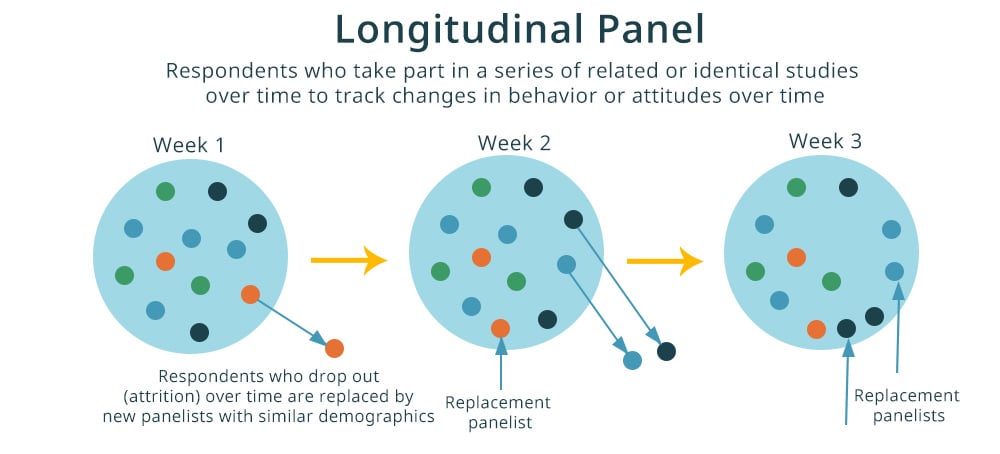On This Page:
A panel study is a type of longitudinal research where data is collected from the same individuals, known as a panel, repeatedly over a period of time to track changes or developments.
When to Use
Panel studies measure people’s behaviors over time, specifically their opinions, feelings, emotions, and thoughts. Researchers in panel studies collect information on the same individuals and gather data repeatedly at different points during the study.
Panel studies are typically used to analyze consumer purchasing habits, the effectiveness of an advertisement campaign, or the projected product sales.
However, they can also be used to research changes in household composition or stability in voting intentions over time. Panel survey data is typically collected through interviews and online surveys.

Advantages
Efficient and cost-effective
As participants willingly participate in panel surveys, these types of studies tend to have high response rates.
The process is continuous, and panels are easy to recruit and monitor, making the process quick and cost-efficient.
Diverse and extensive data
Researchers can collect data from a diverse range of subjects and collect large amounts of information from the same group of respondents.
Accessible
It is much easier to find respondents from a panel than it is to recruit and enroll responses from random individuals.
Limitations
Difficulty with attrition
Panel studies require long-term time investments so that initial samples might be lost to deaths, migration, or loss of interest in the study.
In a panel study, attrition (losing participants over time) is common. Researchers use various strategies to deal with it:
-
Replacement: New participants are recruited to replace those who have dropped out. However, this can introduce bias as new participants may not perfectly match the original ones.
-
Follow-up and Retention Efforts: Researchers make efforts to maintain contact with participants, such as through regular updates, incentives for participation, and flexible data collection methods.
-
Statistical Methods: Techniques like imputation can handle missing data due to attrition. These methods estimate the missing values based on the observed data.
-
Attrition Analysis: Researchers analyze the characteristics of those who dropped out versus those who remained to understand if attrition is random or systematic, impacting the interpretation of the study results.
Response bias
People become experienced interviewees, so questions asked earlier in the study might influence future responses.
Or, if the same questions are asked, it is likely that respondents will answer the same way they did previously because they remember the study.
Change in population over time
Because panel studies are longitudinal in nature, it is possible that the sample may become less representative of the population over time.
In addition, there could be other demographics that need to be taken into consideration but were not included during the initial study design.
Examples
- Studying whether continued exposure to violence on television programs impedes the development of aggressive behavior patterns among elementary and high school children (Milavsky et al., 1982).
- Studying the effect of this attrition on the unconditional distributions of several socioeconomic variables and on the estimates of several sets of regression coefficients (also known as The Michigan Panel Study of Income Dynamics) (Fitzgerald, Gottschalk, & Moffitt, 1998).
- Examining the relationship between management diversity and firm performance in the case of women in top executive jobs and on boards of directors (Smith, Smith, & Verner, 2006).
- Analyzing changes in depression following a divorce (Menaghan & Lieberman, 1986).
- Investigating whether ethnic media use leads to stronger ethnic identification over time (Jeffres, 2000).
- Examining the relationships between the experiences and perceptions of racism and the physical and mental health status of African Americans (Jackson et al., 1996).
Frequently Asked Questions
1. What’s the difference between a panel study and a cohort study?
Panel studies and cohort studies are both types of longitudinal research. In a cohort study, researchers monitor and observe a chosen population who share a common characteristic over an extended period of time.
They observe this population based on the shared experience of a specific event, such as birth, geographic location, or historical experience.
Panel studies involve sampling a cross-section of individuals at specific intervals for an extended period of time. In panel studies, the same individuals are used throughout, unlike in cohort studies.
2. Are panel studies retrospective or prospective?
Panel studies are typically prospective. They involve identifying a group of individuals (the panel) and then collecting data from these same individuals at multiple points in time in the future. This allows researchers to track changes and developments over time.
3. Are panel studies qualitative or quantitative?
Panel studies are typically quantitative, as they involve collecting numerical data from the same individuals over a period of time to track changes and identify trends or patterns.
However, they can also include qualitative elements, such as interviews or observations, to provide a more comprehensive understanding of the phenomena being studied.
Further Information
- Lugtig, P. J., & Smith, P. A. (2019). The choice between a panel and cohort study design.
- Panel studies in developing countries
References
Fitzgerald, J., Gottschalk, P., & Moffitt, R. A. (1998). An analysis of sample attrition in panel data: The Michigan Panel Study of Income Dynamics.
Herzog, A. R. (n.d.). Panel studies – advantages, challenges, data analysis – examples of panel studies for the Study of Aging. Advantages, Challenges, Data Analysis – Examples of panel studies for the study of aging – Age, Developmental, Social, Longitudinal, and Time – JRank Articles. Retrieved from https://medicine.jrank.org/pages/1285/Panel-Studies.html
Jackson, J. S., Brown, T. N., Williams, D. R., Torres, M., Sellers, S. L., & Brown, K. (1996). Racism and the physical and mental health status of African Americans: a thirteen year national panel study. Ethnicity & disease, 6 (1-2), 132-147.
Jeffres, L. W. (2000). Ethnicity and ethnic media use: A panel study. Communication Research, 27 (4), 496-535.
Menaghan, E. G., & Lieberman, M. A. (1986). Changes in depression following divorce: A panel study. Journal of Marriage and the Family, 319-328.
Milavsky, J. R., Kessler, R., Stipp, H., & Rubens, W. S. (1982). Television, and Aggression: Results of a Panel Study.
Smith, N., Smith, V., & Verner, M. (2006). Do women in top management affect firm performance? A panel study of 2,500 Danish firms. International Journal of productivity and Performance management.
UCL Institute of Education. (n.d.). Panel studies. Learning Hub. Retrieved from https://learning.closer.ac.uk/learning-modules/introduction/types-of-longitudinal-research/panel-studies/

